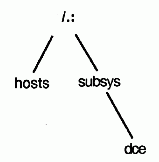CDS Names
Every cell contains at least one server that is running a CDS server. A CDS server stores and maintains names and handles requests to create, modify, and look up data. The total collection of names shared by CDS servers in a cell is called a cell namespace. The cell namespace administrator can organize CDS names into a hierarchical structure of directories. CDS directories, which are conceptually similar to the directories in your operating system's file system, are a logical way to group names for ease of management and use.
In a cell namespace, any directory that has a directory beneath it is considered the parent of the directory beneath it. Any directory that has a directory above it is considered a child of the directory above it. The top level of the cell namespace is called the cell root. You can refer to the cell root either by the global name of the cell or by the short-form /.: prefix.
The following figure shows a simple cell namespace hierarchy, starting at the cell root. The cell root (/.:) is the parent of the directories named /.:/hosts and /.:/subsys. The /.:/subsys directory is a child of the cell root directory and the parent of the /.:/subsys/dce directory.
Sample CDS Namespace Hierarchy

The complete specification of a CDS name, going left to right from the cell root to the entry being named, is called the full name. Each element within a full name is separated by a / (slash) and is called a simple name. For example, suppose the /.:/hosts directory shown in The figure above contains an entry for a host whose simple name is bargle. The CDS full name of that entry is /.:/hosts/bargle. Multiple consecutive slashes are turned into a single slash in a full name.
Multiple directory levels enable flexibility in distributing, controlling access to, and managing many names. A directory hierarchy also reduces the probability of duplicate names. For example, /.:/subsys/Hypermax/printQ/server1 and /.:/subsys/ABC/spell/server1 are unique names.